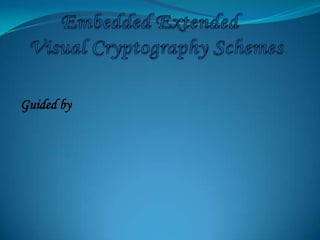
Progre ppt
- 1. Guided by
- 2. Problem Definition When ever we transmit the data(image) in the network, any unauthenticated person can read our data(image). In order to provide security to data(image) generally sender will encrypt the data(image) and send it the intended person and the receiver will decrypt the encrypted data(image) and uses it
- 3. Background Introduction Extended Visual Cryptography schemes. The existing system does not provide a friendly environment to encrypt or decrypt the data (images). Deals only with binary input share images. A larger pixel expansion value. It uses access structure or threshold access structure
- 4. Proposed System Proposed system Visual cryptography provides a friendly environment to deal with images. Deal with Gray scale input images. A minimum pixel expansion. It uses general access structure.
- 6. Administrator Login login Create user Change Delete password user
- 7. Converting color image to binary start j If value> no Input image 122 yes Img(I,J)=0 W=width(img) Img(I,J)=255 H=height(img) Next J for I=1 to W Next I for J=1 o H Output img Value=Get Brightness(P(I,J)) Stop
- 8. Share creation using halftone algorithm If Start Img(I,J)< black Let Img=input image temp(JX2,IX2)=black temp(JX2,IX2)=black W=width(Img) temp(JX2,IX2H)=white temp(JX2,IX2H)=white H=height(Img) temp(JX299,IX2)=white temp(JX299,IX2)=white temp(JX299,IX2H)=black temp(JX299,IX2H)=black Create temp(width,height) Output Next J for I=0 to H-1 Img Next I For J0 to W-1 Stop
- 9. Algorithm2: Halftonig process Input : The c x d dithering matrix D and a pixel with gray-level g in input image I. Output: The halftoned pattern at the position of the pixel For i=0 to c-1 do For j=0 to d-1 to do If g<=Dij then print a black pixel at position (i,j); Else print a white pixel at position (i,j);
- 10. Algorithm 3: Embedding process Input : The covering shares constructed in Section IV, the corresponding VCS with pixel expansion and the secret image . Output: The embedded shares . Step 1: Dividing the covering shares into blocks that contain subpixels each. Step 2: Choose embedding positions in each block in the covering shares. Step 3: For each black (respectively, white) pixel in,randomly choose a share matrix (respectively). Step 4: Embed the subpixels of each row of the share matrix into the embedding positions chosen in Step 2.
- 11. Embedding process Start for I=1 to w-1 Input Img1,Img2 for J=1 to H-1 W1=width(Img1) width(Img2) Out(I,J)=Img1(I,J) or H1=height(Img1)height(Img2) Img2(I,J) If w1=w2 Output Next J No and process H1=H2 fails Next I yes Stop W=W1=W2 H=H1=H2 Stop
- 12. Snap Shots
- 13. Work completed and future work
- 14. Conclusion
